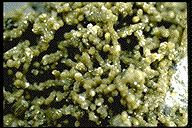 THE
MINERAL NAHCOLITE
THE
MINERAL NAHCOLITE
 THE
MINERAL NAHCOLITE
THE
MINERAL NAHCOLITE- Chemistry: NaHCO3, Sodium Bicarbonate or Sodium Hydrogen Carbonate
- Class: Carbonates
- Uses: as Baking Soda, as a chemical Buffer, and (rarely) as mineral specimens
Specimens
Nahcolite is the natural mineral most familiar to us as Sodium Bicarbonate or Sodium Hydrogen Carbonate or (most commonly) Baking Soda. Yes, there's probably a box of nahcolite in your pantry, possibly another in your refrigerator.
The HCO3 ion in nahcolite's formula is called bicarbonate and is composed of one hydroxide which has taken the place of one of the three oxygens on a normal carbonate ion, CO3. Nahcolite forms large concretionary masses in the oil-shales of the Green River Formation and as an evaporite mineral in non-marine sedimentary deposits. Nahcolite was first discovered as a mineral at Searles Lake, California in 1940 and forms several beds in the lake sediments, some up to two feet thick. Nahcolite can absorb water and specimens should be stored in closed containers.
Nahcolite, as ordinary baking soda, is used to make cookies, cakes, biscuits, and similar pastries "rise" during baking. In the presence of an acid, it easily decomposes into carbon dioxide and a sodium salt of that acid, and the trapped bubbles provide the textures we enjoy in those foods. Note that "baking powder" is a simple mixture of baking soda and a dry acid such as cream of tartar, often with a starch added to provide bulk.
Nahcolite as sodium hydrogen carbonate is used as a buffering agent, since in the presence of an acid it decomposes ultimately releasing carbon dioxide, and in the presence of a base it turns into a carbonate, thus neutralizing the acid or base. It is the most common "Ph increaser" for swimming pools (and ordinary "baking soda" is generally much less expensive than chemically identical "Ph Boosters" or "total alkalinity increasers").
Its ability to absorb moisture and neutralize chemicals results in another common use: to neutralize odors, hence its presence in your refrigerator. Add its relative softness (2.5 on the Mohs scale) which means it is not a strong abrasive, and the result is a common ingredient in toothpaste - or even as a replacement for toothpaste, which often is not much more than a sweetened, flavored paste of nahcolite (used as an abrasive) with various additives which claim to kill bacteria, prevent plaque, reduce odors, reduce sensitivity, strengthen enamel, or whiten teeth.
Nahcolite is one of those rare minerals that are named for their chemistry.
In this case, straight from its formula:
NaHCO3.
Simply replace the (3) with (-lite) and you get nahcolite!
There are similarly named minerals such as
cavansite which stands for calcium vanadium silicate;
PHYSICAL CHARACTERISTICS:
- Color is colorless, white, brown or gray.
- Luster is vitreous.
- Transparency: Crystals are transparent to translucent.
- Crystal System is monoclinic; 2/m.
- Crystal Habits include prismatic crystals, but usually massive crusts.
- Cleavage: There is a perfect cleavage.
- Hardness is 2.5.
- Specific Gravity is 2.2 (well below average)
- Streak is white.
- Associated Minerals include other sedimentary evaporite minerals such as
hanksite,
gaylussite,
analcime,
halite,
pirssonite,
northupite , borax and calcite. - Notable Occurrences include Searles Lake, San Bernardino County and Deep Spring Lake, Inyo County, California and the Green River Formation, Colorado, USA; Egypt and Lake Magadi, Kenya.
- Best Field Indicators: Environment of formation, cleavage, density, crystal habit and locality.








